Sporting Clays on the Bourbon Trail: Part VI, The Inn on Biltmore Estate

Blackberry Farm receded at a brisk clip as I drove the Porsche Cayenne S west along the Lamar Alexander Parkway through Tennesse’s Great Smoky Mountains toward our next destination – The Inn on the Biltmore Estate in Asheville, North Carolina.
The Lamar Alexendar Parkway presented a superb stretch of American highway. The Great Smoky Mountains bestowed a warm, benevolent morning with the radio tuned to satellite-radio XM 14, Bluegrass Junction, regaling us through 14-speaker surround sound.
This was cruiser territory, the kind of road you could enjoy in any SUV with lush leather and a premium technology package. Some six miles later, though, the Cayenne S would fully reveal it’s Porsche DNA and make you eager to cough up the $30,000 premium over a fully loaded Chevy Suburban. Certainly, that $30,000 isn’t chump change and would definitely supply the five-figure fodder for heated debates over beers and burgers. But Porsche’s Cayenne has been embroiled in controversy from its inception, although the vitrioil has mellowed over the years.
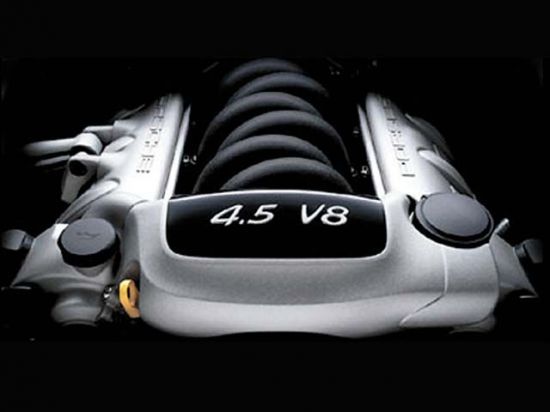
When Porsche introduced the Cayenne in 2003, purists hurled blasphemous molotovs at CEO, Dr. Wendelin Wiedeking. They accused him of betraying owners of the legendary 911 heritage of rear-engine, two-seater, record-beating, neck-snapping sports cars. After all, it was bad enough when Porsche launched the first front-engine models in the mid-70s, the 928 and 924, but at least they were sports cars. Now a Porsche for soccer moms?
Worse, the Cayenne ran with a front-mounted, liquid-cooled V8 instead of Porsche’s venerble and beloved air-cooled, opposed, flat six hanging over the rear wheels; plus the Cayenne committed four-door sacrilige.
Over the years, though, the Cayenne gained street cred and ascended to Porsche’s top seller. Why? It turns out we didn’t have to look any further than route TN-35/US-411 to vouch for the Cayenne’s Porsche birthright.
After a blissful 7½-mile stretch on the Lamar Alexendar Parkway, we exited onto TN-35/US-41, which would later link us up with Interstate 70 for the remainder of the 130-mile drive to Asheville. Now it was time for Sport Mode.

A button on the center console lets you select between three performance settings: Normal, Comfort and Sport. Choose Sport and the suspension hunkers down while sharper shift points last into a higher rev range. At the same time, the 8-speed Tiptronic S transmission offers manual shifts via two stainless-steel paddles shaped like angel’s wings integrated into the three-spoke steering wheel. One paddle is for upshifts, the other for downshifts (you can also use the gear selector on the center console). Of course, Porsche leaves nothing to chance. An electric pump exerts transmission-fluid pressure for assured performance at lower engine revs – ensuring that the 400-horsepower V8 under the hood efficiently transmits the brute force of MMA heavyweight champ Brock Lesnar to all four wheels.
In Sport Mode, I paddle-shifted up and down through the gears. Assuming the stiff-armed racing position, we zig-zagged through sections of S-curves on 20-inch tires. The Porsche Cayenne S belied its 4,500-pound heft – remaining nuetral and controllable throughout. Bear in mind that the Porsche Cayenne S weighs about 1,500 pounds more than a new, rear-engined Carerra – meaning the SUV will never match the handling of Porsche’s flagship sports car. Still, it’s mind-blowing to wring out the Porsche Cayenne S at speeds that would make other SUVs give up the ghost. If you drive a mega-hauler like a Suburban, and don’t have a spare $30,000 in your checking account, we urge you not to test drive a Porsche Cayenne S on snakey back roads for the temptation is mighty and divorce is almost certain.
When the sign for I-40 came into view, the Porsche Cayenne S went back into Normal, where it remained for the next 75 miles until we arrived at The Inn on Biltmore Estate. If “inn” conjures up a cozy Cotswolds public house, get ready for a major surprise.
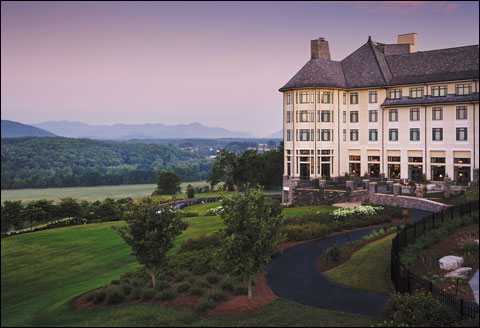
The Inn on Biltmore Estate is a modern, streamlined rendition of George Vanderbilt’s 250-room French château and gardens completed in 1895 elsewhere on the 8,000-acre estate. The 201 guest rooms and nine suites of the Inn on Biltmore Estate cater to families seeking a kid-friendly resort with an upscale ambiance. There’s plenty to keep the pod busy here: horseback riding, bicycling, off-roading, wine tasting, property tours, fly fishing, hiking and of course sporting clays.
Arrive at the main entrance and a bellhop immediately greets you, unpacking the vehicle in an appreciative, can-do demonstration of hospitality and efficiency. We’re always attentive to gun-storage policies and the Inn on Biltmore Estate allowed our cased shotguns in the room.
The lobby conveys the hotel’s other facet as a venue for weddings, business meetings, team-building exercises and other group events. Once upstairs, however, our spacious room suggested an intimate, contemporary country estate with posh furnishing and tasteful décor. The character of the room successfully combined dual phone lines with conference calling with plush terry bathrobes and matching slippers at your disposal in the ample closet.
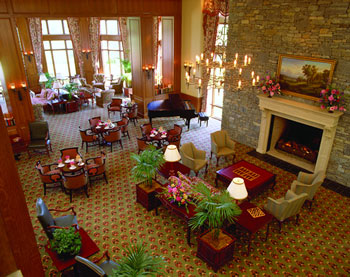
We had arrived in a cruise-ship state of mind (where you’re always waiting for the next meal), and reviews posted on various travel web sites had stirred up our gastric juices. Guests who had stayed at the Inn on Biltmore Estate consistently awarded four and five stars for both accommodations and food. Okay, bring it on.
The spacious dining room teetered on the generic, yet conveyed an undertone of elegance, even though the piped-in chamber music verged on the saccharine. The service would prove itself magnificent from the opening: our server saw that my traveling companion wore black and consequently replaced the standard white linen napkin with a black one to thwart lint. Now that’s hospitality.
A quick review of the menu further revealed a master at work. If you’re a fellow fan of Gordon Ramsey’s TV show “Kitchen Nightmares” you learn that one sure sign of an amateur chief is a huge menu. As chef Ramsey has repeatedly demonstrated, a sprawling assortment stretches the kitchen beyond limits of excellence – often exacting the foulest of short cuts such as frozen versus fresh ingredients and food prepped too far in advance evocative of mom’s lunch-bucket quickie mummified in wax paper.
The menu in the dining room of the Inn on Biltmore Estate illustrated an erudite selection that ensured both freshness and variety to satisfy most guests. It was clear that the restaurant’s emphasis was on the food enhancing the ambience rather than the other way around. In the same manner, the menu itself was easy to read in the romantic lighting – forsaking the flourishes and parchment themes that begrudgingly bring out the glasses.
We usually polish off a bottle of wine with dinner, but instead that night gravitated toward house selections by the glass – a refreshing chardonnay and an overly sweet sauvignon blanc.
Ravenous, we devoured the kitchen’s breads served with a creamy salted butter, soon followed by an amuse-bouche of delicious mushroom-fennel soup.
Given our choice of wine, we order seafood. The scallop appetizer was perfectly seared and garnished with citrus and fresh greens. The trout rivaled wild salmon for meatiness and consistency. It arrived accompanied by a wonderful corn-cake soufflé. For the main course, an out-of-shell lobster tail and ravioli stuffed with butternut squash puree and lobster bits were home runs in the ballparks called our stomachs. Dessert was an oversize pumpkin soufflé that we both ranked as spectacular.
The glorious morning weather had set the stage for a lovely Southern night, and so after a stroll around the inn’s gardens we hopped the shuttle to the Antler Hill Village and Winery. The term village was certainly questionable, as the scene appeared more Southern California, mission-style shopping mall. The tasting room was closed, but had we arrived earlier certainly would have tried the Biltmore vintages now in production for some 25 years. Instead, we dropped in at Cedric’s Tavern for a couple of cognacs at a terrace table before riding the last bus of the night back to the hotel.
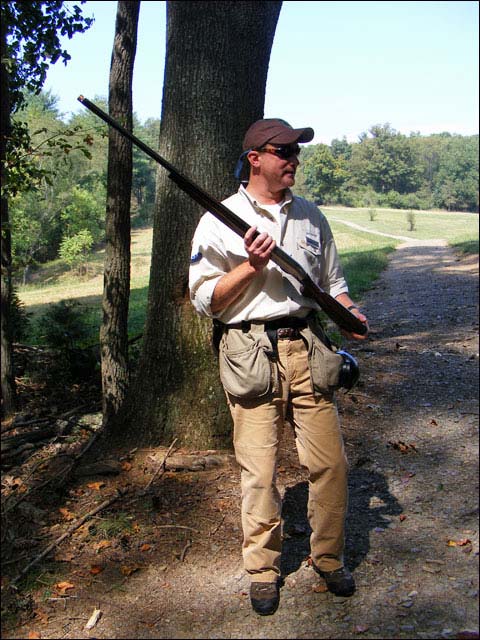
The sun rose on a morning of sporting clays. Darren Moore, the Biltmore’s Fly Fishing and Sporting Clays Instructor, had driven us some 20 minutes to their course. Entering the property, heavy equipment immediately caught our attention. Darren explained that a bridge was under construction to dramatically reduce the ride time from the hotel to the sporting clays course.
We arrived, emerged from Darren’s Land Rover and realized something was out-of-kilter: something was missing. Where’s the club house? We stood in a field with a few sporting clays stations (plans were drawn for a covered, heated 5-stand). Our expectations of the Biltmore initially were certainly higher, but Darren explained that the Biltmore’s 50-shot sporting clays course mostly serves new shooters staying at the hotel. A session with him or any of the other three NSCA Level I instructors generally lasts about two hours, tops.
As an instructor, Darren wants to imprint hotel guests with at least one essential message: focus on the target. Our entire time with him was devoted to improving target focus. Ultimately, if you don’t focus on the target, and more specifically on the right piece of the target, you could be shooting a $20,000 shotgun and still consistently miss the bird.
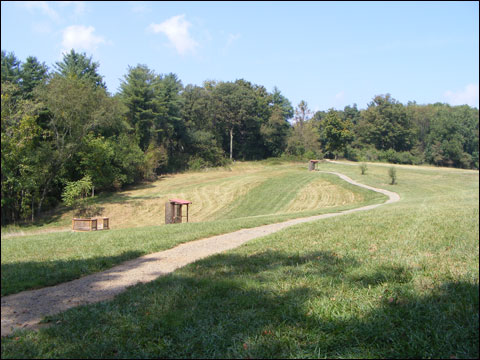
Darren’s exercise in focus begins at a pair of stands in the middle of a field with easygoing incomers thrown from the tree line. At first, these targets appear as lollipops. High and lazy, they show a full black underbelly. They slowly draw near…but are you really seeing them, are you focused on them with the intensity of a surgeon with scalpel in hand?
Slow incomers drive home Darren’s point that too often shooters mistake target acquisition with target focus. The difference? When you acquire a target, you generally look at the whole target. When you focus on it, your eyes are riveted to the part of the target you’re going to hit.
For example, on a left-to-right quartering bird, you want to focus on the leading edge. On a going-away target, you want to focus on the tail end. On a rabbit, you want to focus on the feet.
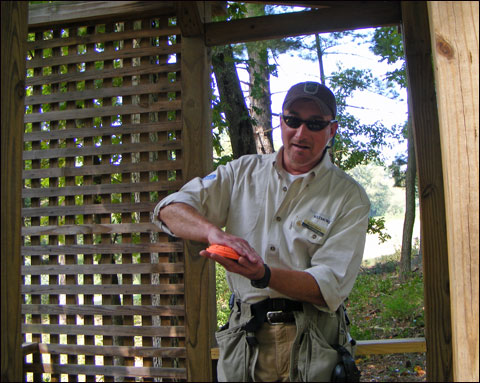
“Don’t engage the gun until you focus on the target,” Darren says.
A frequent oversight by shooters is a phenomena he calls “split focus.” It’s when the act of mounting the gun distracts the shooter from complete target focus. “The gun is not mounted until you have focus,” he emphasizes.
So for experienced clays shooters, the slow incomers offer a lesson in building consistency through focus. The big, round, black surface hanging there can easily trick the shooter, he explains.
“When you concentrate on seeing the whole target, your mind tells you you’re there, and you’ll be shooting at the back end of the target.” By focusing on the portion of the target you need to hit (usually the leading edge), you don’t have to look back at the gun to recalibrate the shot.”
In effect, target focus tends to slow down the entire shot. Likewise, you become reacquainted with your shotgun. Instead of grabbing it off the rack, stepping into the box and calling pull, the slow-motion effect enhances the feel of the grip, the forend in your palm, your cheek touching the comb, the sensibility of the trigger and the balance of the shotgun as it rises to your shoulder.
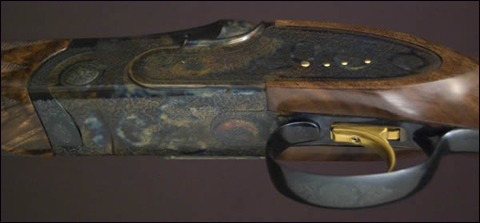
Since I was fortunate enough to be shooting a 12-gauge A-10 American on loan for the trip from Connecticut Shotgun, this Zen-like style brought about a purposeful consideration of the gun’s dynamics. If you are unfamiliar with the A-10 American, it’s a case study in form enhancing function.
The A-10 American is an over/under with a very low profile made possible through dual sidelock actions. New hand-detachable sidelocks are rare enough in the under $10,000 market, but finding an over/under is near impossible since most are side-by-side bird guns adhering to the traditional double triggers.
The receiver and all the main parts are made from a solid block of steel. The action features V main springs and safety sears that promote smooth and reliable trigger pulls.
An A-10 American is equipped with a weight-balancing system in the butt stock to personalize the balance point (or you can remove it to shave some weight). In addition, the barrels under the forend accept weights to quickly alter the swing effort.
Now imagine savoring that shotgun on repeated slow incomers. Every nuance of the shotgun shines. You revel in the balance, the crisp trigger and riveting sight picture.
We spend at least an hour shooting the lethargic incomers in one of the best lessons we’ve taken on building consistency. Afterwards, we move into the woods where a few more stations threw harder presentations. By now, Darren’s instructions are drilled into our brains and we use the time to bone-up on target focus. Practicing focus on easy targets is one thing; applying that lesson on low-quartering birds zipping between the trees is another beast entirely, and it certainly brought out the eagerness of the A-10 American to kill fast birds.
Shooting sporting clays at the Inn on Biltmore Estate presented one more example of what you can expect at pricy, family resorts. Typically, the targets will be easier than you’re accustomed to shooting, but they reveal a treasure trove of sporting clays fundamentals that we either forgot or were buried under the rubble of bad habits accumulated over the years.

Often, you’ll be paying $150 to $200 or more per appointment. At those prices there’s no reason to impress your instructor. Cork the testosterone. Relax into the exercise, soak up the advice, benefit from that subtle surge in confidence you’ll inevitably enjoy from powdering targets set for green shooters. Shooting with Darren proved a prime example in opening up to new insights gained by totally availing yourself to the experience.
While staying at the Inn on Biltmore Estate, make sure you visit the Biltmore House Mansion. The ornate four-story French Renaissance manor has exterior walls of Indiana limestone and a pitched copper roof. It’s the kind of building you associate with a historic drama on Masterpiece Theater. Designed as a country retreat for the Vanderbilt family, it’s the largest private house in America with an interior floor area of 250 rooms covering four acres. Frederick Law Olmsted designed the three-mile approach road and the estate’s grandiose gardens. Included on the estate’s present 8,000 acres are vineyards that provide more than 250 tons of grapes for the Biltmore Estate Winery – certainly a good reason to visit.
Back in the Porsche Cayenne S, we set our sights on a four-hour drive to Meadows of Dan, Virginia where we would shoot the most beautiful sporting clays course in America: Primland.
Irwin Greenstein is Publisher of Shotgun Life. You can reach him at letters@shotgunlife.com.
Previously published instalments of “Sporting Clays on the Bourbon Trail”:
Sporting Clays on the Bourbon Trail: Part I, Nemacolin
Sporting Clays on the Bourbon Trail: Part II, Elk Creek Hunt Club
Sporting Clays on the Bourbon Trail: Part III, White Dog Mash and Other Delights
Sporting Clays on the Bourbon Trail: Part IV, The Rockcastle Shooting Center
Sporting Clays on the Bourbon Trail: Part V, Blackberry Farm
Useful resources:

Irwin Greenstein is Publisher of Shotgun Life. Please send your comments to letters@shotgunlife.com.


Comments